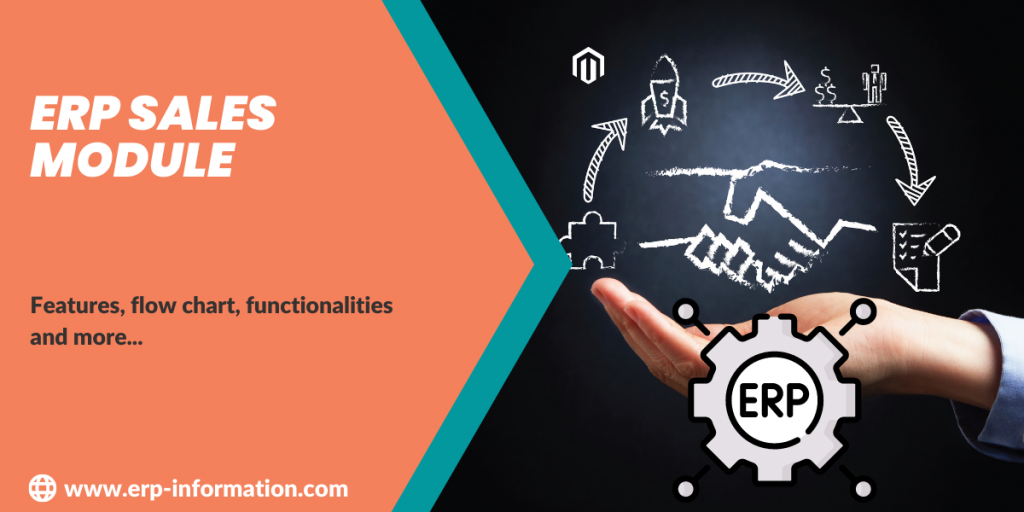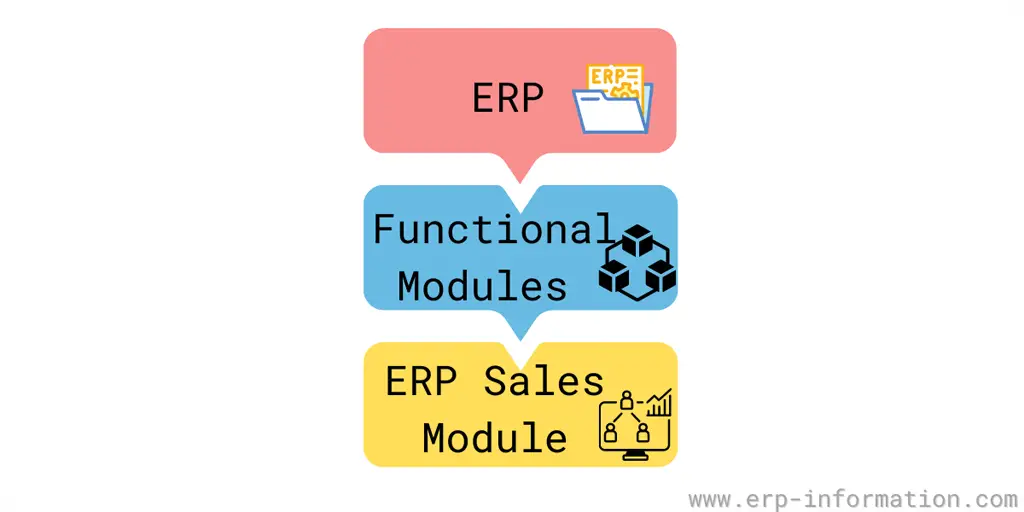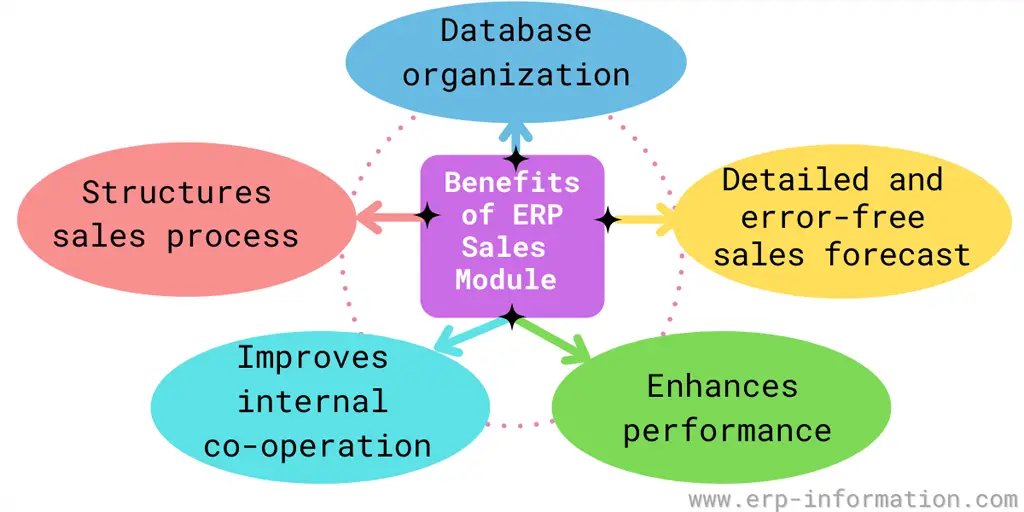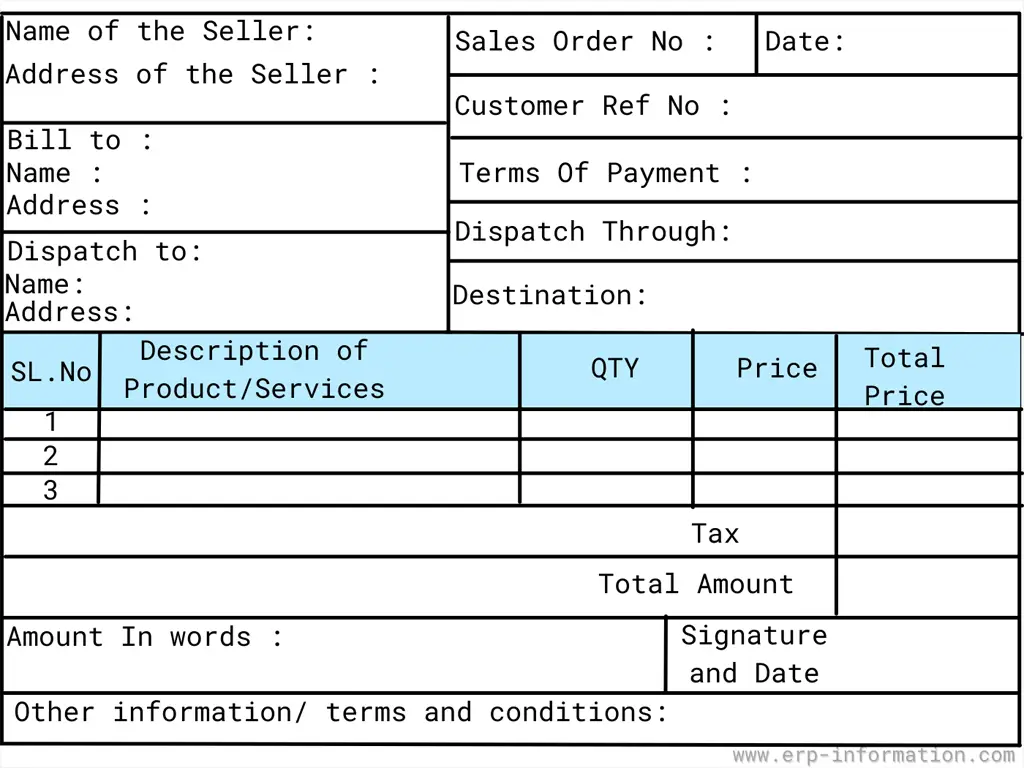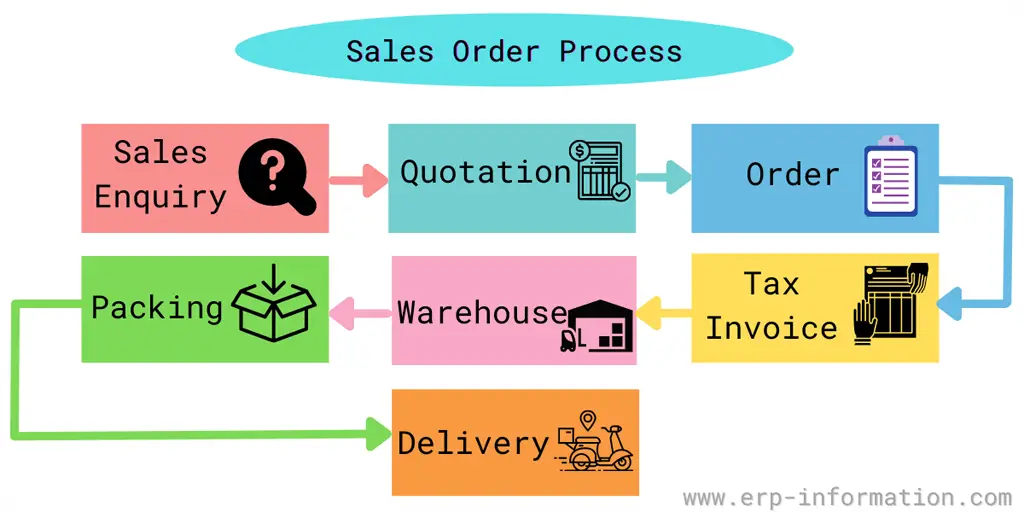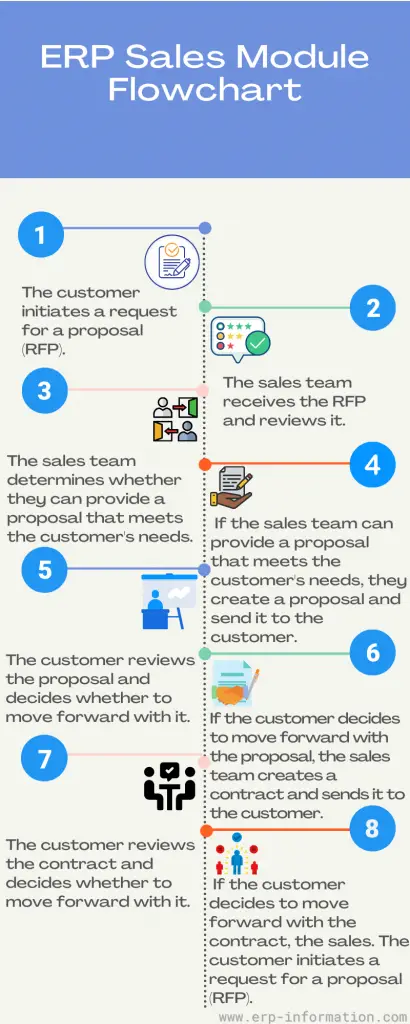Begin a journey through the heart of streamlined business operations with our comprehensive guide to ERP Sales Modules. It is an integral part of the ERP system. It helps in managing sales and marketing activities effectively.
This post will discuss the features and functionalities of the sales module, its flowchart, and how it works with other modules in the ERP system. It also briefs about sales orders and sales order processing.
What is the ERP sales module?
ERP sales module implements order placement, order scheduling, shipping, and invoicing functions.
This module helps in sales planning too. Sales planning determines the sales rates the company must maintain for its product lines to meet the strategic plan.
Most of the ERP systems available in the market today have an ERP Sales module.
This module works with the logistics system of an organization. It also interacts with CRM systems.
This module handles marketing and distribution too. In the case of SAP, sales and distribution are a components of the logistics module.
The ERP sales module integrates with organizations’ e-commerce websites. Many ERP vendors offer an online storefront as part of the sales module.
ERP marketing module, along with CRP (customer reference program) support,
- Lead generation
- Direct mailing campaign
- Other marketing works
- Scheduling of the promotion
ERP sales module features
- Checking the price of goods and services like rebates or discounts given to a customer.
- Checking the availability of a product in stock.
- Generating bills or invoices.
- Determine the details of materials based on conditions.
- A simple credit check and automatic credit check for managing the customers’ credit limits.
- Determining the details of customers based on different conditions.
- Determining and managing information about salespersons.
Detailed functionalities list of ERP sales module
- Handles pre-sales and sales activities of the organization
- Complete stock-to-dock tracking of the sales order processing cycle
- SalesForce Automation. Prospect is tracked through various stages. Detailed location-wise competitor product information. Scheduling marketing executives’ visits and tracking expenses.
- Marketing surveys for estimating the demand for various products. These surveys will help in preparing an effective marketing strategy.
- Detailed customers, business partners, and dealers database. These entries include bank details, TDS details, contact details, and credit limits.
- Target setting for executives
- Order amendment history
- Authorization of orders and invoices
- Customer order scheduling over a period of time and tracking delivery schedule
- Order tracking through status and transaction reports
- Generation of production advice to plan for production based on sales orders
- Order processing is based on the maximum retail price (MRP)
- Preparation of dispatch advice
- Many dispatches against single sales orders (SO)
- Invoice generation with advance adjustments and sales vouchers are automatically generated in finance.
- Tracking sales returns
- Association of customers to marketing executives and business partners for tracking
- Flexibility to define customer-specific prices for products and reference customer part numbers
- Multiple dispatch locations for customers and dealers
- Complete export documentation for export-oriented companies
- Excise details. (chapter number associated with excisable products)
- Inquiries from potential and existing customers
- Quotations and amendments to quotations with complete history
- Analyzing lost jobs
- Different types of orders can be generated to suit the varied needs of customers
- Order entry for direct/scheduled/open/D3 sample orders. This will also include details for dealers, incentive percentages, and compensation
- Order calculation based on price offered discounts (line and total), excise, taxes, and freight.
- Letter of credit details for association with sales orders
- Rejection invoice for rejections made against purchases with excise consideration
- MIS for analyzing sales trends to project and forecast sales
- Stock transfer between warehouses for multi-location companies
- Service invoice for services given to customers
- Variance reports
- Enables top view – consolidation of sales data for all child companies
- CRM integration through the Internet. Posting inquiries and sales orders on the web by customers. Importing the same into ERP after validations.
Decide your product MRP using our Online maximum retail price calculator
ERP Sales module is an essential function for an organization. Sales handle all the activities for domestic and export sales of an organization.
The customer and product databases are maintained in the ERP sales module. The module facilitates sales cycle steps. Broad steps include,
- Capturing inquiries
- Order placement
- Order scheduling
- Dispatching
Stock transfer between warehouses is also covered.
Besides all this, you can also generate reports to help with decision-making and strategic planning. The information will guide you in making the right choices for your business. You can also export the documents to use however you need.
Benefits of the sales module
Here we are listing the benefits of the ERP sales module for B2B businesses.
Database organization
This module allows you to have complete details of your customers. It provides sales, distribution, marketing, and customer service data in an organized form.
It also provides you with accurate, real-time data that helps you in decision-making.
Detailed and error-free sales forecast
This module records the data effectively with all essential things. This efficient and real-time data helps the sales department make accurate sales forecasts.
Enhances performance
ERP sales module updates data, meeting scheduling, follow-up notifications, scheduling works for the sales process, etc.
Hence salespeople can concentrate more on sales. It improves their performance.
Improves internal cooperation
The module helps salespeople work together better. It gathers everyone’s work and shows it in a way that everyone can understand. This makes it easier for everyone to work together.
It also allows you to access the data easily. It helps to decrease time consumption by avoiding unnecessary meetings.
Structures sales process
It allows the sales team to view all the required information in one place. So the salespeople can manage, track, and monitor all the sales process stages as per their status.
How does the ERP sales module work with other modules in the ERP system?
The ERP Sales Module integrates with other modules in the system, such as the Accounts Receivable and Accounts Payable Modules. It also interacts with General Ledger and Inventory Control Modules. The Sales Module interfaces with the Human Resources Module to track employee performance. Finally, it works with the Customer Relationship Management (CRM) Module to keep track of customer data.
What is a sales order?
A sales order is a document generated by a seller upon receiving a purchase order from a buyer, indicating the details of the sale and the goods or services to be delivered.
It includes product or service details, the price of the product/services, the number of units, and terms and conditions. It serves as a confirmation of the buyer’s intent to purchase and the seller’s agreement to supply the specified items under the agreed-upon terms.
Sales order format
Sales order contains the following things.
- Name and address of the vendor
- Name and address of the billing (customer’s billing address)
- Name and address of the shipping (customer’s shipping place address)
- Details about products or services
- Price per unit
- Quantity of each product
- Term or mode of payment
- Tax payable
- The total amount, including tax
- Authorized signature
- Other information, if any, or terms and conditions
How do you process a sales order?
Below are the steps to process the sales order.
- The customer raises a requisition for a quotation from the seller.
- The seller generates and sends the quotation after receiving the requisition from the customer.
- If the quotation is reasonable and affordable to the customer, they generate a purchase order and send it to the seller.
- Using the information given in the purchase order, the seller generates a sales order. Then the vendor sends this sales order to the customer to check the terms of the sale.
- According to the order, the seller delivers the product or services.
- With the help of the sales order, the seller generates an invoice and sends it to the client.
- The customer pays the amount in the invoice within the specified period.
You can calculate purchase order finance using our Online Purchase Order Financing Calculator
Sales order processing in ERP
ERP sales module helps your organization to process the sales order step by step automatically.
- Resource allocation starts with procuring raw materials from stock as soon as the sales order is generated.
- Then the sales order reaches the production department. Finally, the sales order arrives at the packing department once the ordered products are assembled completely.
- The automated invoice is created when products are ready to dispatch with sales orders, including tax and freight charges.
All these processes go automatically with the help of the ERP sales module.
That helps all the organization departments monitor the sales order progress in real-time to schedule their work accordingly.
ERP sales module flowchart
The flowchart below illustrates the main steps in the process (ERP sales module flowchart):
- First, the customer initiates a request for a proposal (RFP).
- The sales team receives the RFP and reviews it.
- The sales team determines whether they can provide a proposal that meets the customer’s needs.
- If the sales team can provide a proposal that meets the customer’s needs, they create a proposal and send it to the customer.
- The customer reviews the proposal and decides whether to move forward with it.
- If the customer decides to move forward with the proposal, the sales team creates a contract and sends it to the customer.
- The customer reviews the contract and decides whether to move forward with it.
- Suppose the customer decides to move forward with the contract, the sales. The customer initiates a request for a proposal (RFP).
Conclusion
In this post, you learned about the importance of having a sales module in an ERP system and how it can help improve your company’s internal communication. You also learned what information is included on a standard sales order form and easy ways to process one.
It may seem like there are many steps involved with processing a sale, but when they’re all done automatically by software like the ERP Sales Module, things go much more smoothly.
Get more information about the ERP sales module and other related ERP modules here.
